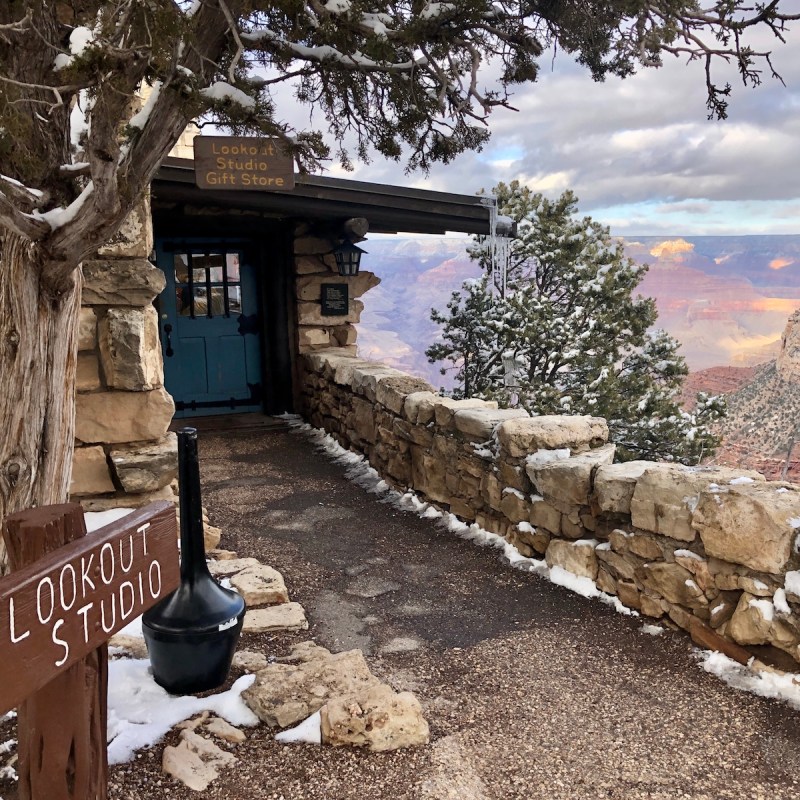
From a certain angle and in just the right light, the rough-cut limestone blocks that make up the walls of the Lookout Studio on the South Rim of the Grand Canyon seem to blend in with the rock canyon walls that rise up behind it. It’s no accident; that was the goal of early-1900s architect Mary Elizabeth Jane Colter, who designed the building to be harmonious with the rugged canyon terrain.
Videos by TravelAwaits

By using locally quarried Kaibab limestone and indigenous building techniques, Colter strove to create the illusion that the studio grew naturally from the edge of the rim, according to Grand Canyon National Park’s website.
The Lookout Studio was just one of Colter’s accomplishments at the park. In an era when the development of national parks was almost exclusively the domain of men, it was Colter’s vision that was behind much of the look and aesthetic of Grand Canyon National Park. In addition to the Lookout Studio, she was the architect for the stunning Desert View Watchtower and the rustic Bright Angel Lodge, along with a handful of other iconic buildings at the Grand Canyon.
Colter was a woman well ahead of her time in many respects. Along with being one of the first female architects in the United States, she was a leader in the 20th-century trend to blend architecture with nature. And, according to the 2002 book Mary Colter, Architect of the Southwest, “Colter deserves standing as a pioneer practitioner of the architecture that came to be known as ‘National Park Service Rustic.’”
Born in 1869, Colter studied art and design at the California School of Design (now the San Francisco Art Institute) and went on to work as the chief architect and decorator for the Fred Harvey Company for 38 years. Over that time, she was central to the company’s development of the shops, galleries, and hotels at the Grand Canyon.
Whenever I gaze up at the towering Desert View Watchtower — my favorite overlook at the canyon — I take a moment to admire Colter’s vision. I believe her pioneering spirit should be celebrated year round, and especially during Women’s History Month in March.
Here are six iconic buildings in Grand Canyon National Park that Colter designed.

1. Bright Angel Lodge
Located just steps from the trailhead for the legendary Bright Angel Trail, the Bright Angel Lodge occupies prime real estate. And the rambling stone-and-log lodge, designed by Colter in 1935, more than holds its own.
I’ve visited the Bright Angel Lodge frequently in the spring, summer, and fall, but it was on my most recent visit on a wintry day in early March that I think the Bright Angel Lodge shone the brightest. Outside, clusters of icicles hung from the eves around the big stone chimney, and inside the lobby, bundled-up visitors seemed to be mesmerized by the fire roaring in the massive fireplace.
The Grand Canyon’s website notes that Colter was tasked in the 1930s to design a fresh look for the Bright Angel Lodge in an effort to provide more moderately priced lodging, in comparison to the South Rim’s other major hotel, the opulent El Tovar.
Like with her earlier Grand Canyon buildings, Colter drew inspiration from native materials and building techniques. The “geologic” fireplace in the lobby depicts the rock layers of the Grand Canyon — “from the river cobbles to the youngest stone strata on the rim,” says the park’s website.
Today, the Bright Angel Lodge and Cabins offer 90 lodging units ranging from cozy historic units with shared bathrooms to standard lodge rooms, historic cabins, and the one-of-a-kind “Buckey O’Neill Cabin.” Reservations are available at the Grand Canyon Lodges website.

2. Lookout Studio
Designed in 1914 as a place for visitors to take pictures of the huge expanse of the canyon, the Lookout Studio sits precipitously at the very edge of the South Rim.
Colter reportedly fashioned the studio after the ruins of Puebloan dwellings found in the region. Borrowing from the natural terrain of the landscape, the building’s rooflines and stone chimneys mimic the irregular shapes of the surrounding rocks.
Today, the studio’s outdoor terrace and observation areas serve as ideal spots to take in wonderful views of the canyon, while the inside serves as a small souvenir shop.

3. Desert View Watchtower
Perhaps no structure epitomizes the Grand Canyon quite like the Desert View Watchtower at the eastern entrance to the national park. The 70-foot-high rock structure is featured prominently on souvenir posters, T-shirts, and calendars. Exploring the area around it is a not-to-be-missed Grand Canyon experience.
The tower was built in 1932 and is recognized as a national historic landmark. According to the Grand Canyon website, Colter patterned the watchtower after those found at Colorado’s Hovenweep National Monument, as well as the Cliff Palace Round Tower at Mesa Verde National Park.
Interpretive signs at the site note that the watchtower creates an illusion of age, but the actual construction tells a more modern story. “Workers built a concrete and steel reinforced superstructure and then applied a veneer of native stone,” says one the signs. “The weathered stone exterior creates the desired effect of a structure rising from the canyon.”
Another sign notes that Colter’s attention to detail is reflected in every element of the watchtower. “Each rock and painted wall was intended to convey meaning,” it says. “Colter used ornamental details, seemingly haphazardly, to create an added charm of the unexpected.”
I love the Desert View overlook not just for the watchtower but for its amazing view of the canyon. The lovely blue ribbon of the Colorado River dazzles from the Desert View, and the walls of the canyon offer a dramatic backdrop. Although the Grand Canyon Village on the western side of the park has great views, as well (and more services), the Desert View is definitely worth the 25-mile drive from the Village.
Pro Tip: When I visited the watchtower in February 2022, the upper levels of the structure were closed to the public, and the Grand Canyon’s website says they are closed until further notice. If and when the upper levels do open back up, the climb up the tower yields wonderful views of the canyon spread far below.

4. Phantom Ranch
In 1922, at the age of 53, Mary Colter was given the assignment of designing a small complex of cabins deep in the Grand Canyon. She called it Phantom Ranch, and 100 years later, the rustic river-rock cabins still serve as a stopping-off spot for the intrepid hikers, mule riders, and rafters who make the arduous trek into the inner canyon.
Phantom Ranch is located in an incredibly scenic setting beside the Bright Angel Creek and near the Colorado River, 9 miles by trail from the South Rim. Colter designed the cabins to be built of wood and native stone to fit in with the natural beauty and solitude of the setting. The grouping of distinctive-looking cabins surrounded by towering cottonwood trees is an instantly recognizable image of the Grand Canyon.
Today, the Phantom Ranch Canteen is famous as a spot for hot and weary hikers to refresh with a glass of lemonade.
(Note that throughout much of 2022, repair work will be underway on the Phantom Ranch’s wastewater treatment facility, and occupancy will be reduced at Phantom Ranch and its canteen. More information is available in this travel advisory.)
Pro Tip: The Phantom Ranch can be reached via the famous Bright Angel or Kaibab Trails, or by raft on the Colorado River. Hiking into the Grand Canyon is considered a difficult excursion and should be attempted only by experienced hikers and in the cooler-weather months. For tips on hiking into the canyon, see 10 Tips For Hiking The Grand Canyon, and 11 Things To Know Before Hiking Rim To Rim In The Grand Canyon.

5. Hopi House
In her first Grand Canyon project, Colter took on the Fred Harvey Company’s commission to design an art and souvenir building along the canyon’s South Rim. Grand Canyon National Park’s website notes that Colter — a “talented and stubborn architect” — was determined to design something that appeared “native, natural, and timeless.”
The result was the large, multi-story Hopi House, made of stone masonry and shaped like a Hopi pueblo. She is said to have modeled the building after the 1,000-year-old dwelling of the Hopi village of Old Oraibi.
The Hopi House has been offering authentic Native American arts and crafts for more than 100 years, and it also carries many other items for sale.

6. Hermits Rest
Sitting at the end of the Grand Canyon’s Rim Trail is Colter’s Hermits Rest, a rustic structure built in 1914 to resemble an old miner’s cabin. It features native stonework, a giant alcove fireplace, and a front porch.
Like Colter’s other buildings at the Grand Canyon, Hermits Rest is crafted from native materials that blend in with the natural surroundings.
Today, the Hermits Rest building offers a gift shop, snack bar, and west-end view of the Grand Canyon. Restrooms and a water station are available outside.
Pro Tip: Hermits Rest serves as the gateway to the backcountry hiking trails that originate from the winding pathway of the Hermit Trail, located about a quarter mile west of the Hermits Rest building.
While you’re in the mesmerizing state of Arizona, consider:
